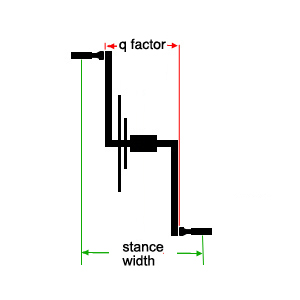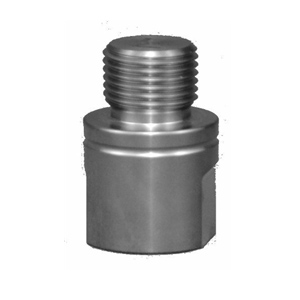Stance Width

This week I'm engaging myself as ombudsman reprimanding… myself. I am republishing two articles written over the past few weeks.
In one case—on stance width—I was devastatingly obtuse in my reasoning. Embarrassingly so. What's below is the article I wrote last month, with the changes embedded in it that make it lucid and useful.
It's not that it was wholly without merit when it debuted. The problem was in my failure to recognize that there should be, and is, a difference between q factor and stance width, and that stance width should probably make it into our lexicon as an important metric.
Q factor was coined a generation ago by Bridgestone Bicycle's Grant Peterson. It is not a term descriptive or recognizable to the typical person. It’s the distance from one pedal shoulder to the other. Imagine that point in space where the pedal meets the crank—not where the threads penetrate into the pedal eye, but where the flat of the pedal spindle meets the lateral side of the crankarm. From that point to the centerline of the bike, times 2, that’s stance width.
For road and tri bikes, it’s about 150mm. That’s typical of most Shimano and SRAM road cranks. Campagnolo’s cranks are built a bit closer together. The stance width of a Campy crank is about 145mm.
Now, here’s something you might find surprising. When you jump on your mountain bike, are you aware of a change in q factor? It’s about 175mm on your MTB. That seems a pretty big difference not to notice. But I’ll bet most of you weren’t aware of the difference in q factor when you jump from one bike to the other. Q factor widens on mountain bikes because of the width of the tire, which pushes the chain stays outboard, which creates a clearance problem—the heel of your shoe hits the bike’s chain stay. So, to move shoes outboard, q factor is increased.
Tread width—as Speedplay's Richard Bryne calls it—and stance width, the term favored by wedgemaster Paul Swift (who teaches pedal/shoe interface at our F.I.S.T. Workshops), is a bit different from q factor. Q factor is a component of stance width, but it's not synonymous. Speedplay pedals offer 4 spindle lengths. If you swap a stock 53mm spindle for a 59mm spindle, as I have done for my road bikes, q factor does change. But something changes. My feet are further away from centerline of the bike. Hence the need for this new metric.
Tread width? Yes, technically right, but too many people think I’m talking about something to do with a bike tire. So I’ve landed on stance width as the term I prefer, partially because the other two terms have disqualified themselves for the reasons stated, partially because I can’t think of stance width without thinking “wide stance”, which gives me a chuckle, and I’ll just leave it at that.
Speedplay's spindle lengths are measured from the pedal shoulder—where q factor leaves off—to the center of the pedal platform. This is handy, if you want to measure the absolute width from one pedal platform to the other. In this case, if my Cervelo R3's q factor, as set up with its SRAM shift system and Rotor crankset, has a q factor of 150mm, and my Speedplay pedals have a spindle length of 59mm, then, 150mm plus double the spindle length gives me a stance width of 268mm.
Now, you might think this wide, with these long spindles. But, a 54mm spindle (pretty standard) in an MTB, as noted, would yield a stance width of 283mm.
Does it make any difference what the stance width is on the bike you’re riding? Yes, and no. Paula Newby-Fraser famously won the Hawaiian Ironman multiple times on a bicycle with a huge stance width. Her Hamilton featured a “drop center” crank, basically a short crank arm attached to the outside of the bike's standard crankarm, and the pedal attached to the outside of all of that. Watching Newby ride that bike from the rear was a little like watching a speed skater from the rear.
Still, changing stance width often fixes a pedal stroke problem. The typical problem for which this is the solution is knees tracking outward at the top of the pedal stroke. Imagine a grown-up riding a child’s tricycle. Knees tracking outboard is a common problem in cycling. If one ascribes to the notion that the tibia ought to track straight up and down (when observing from the front of the bike), and the knee ought to track vertically, rather than moving from side to side, matching a rider to his proper stance width can help.
How do you know what your proper stance width is? There is only one good way that I know of. Ride a bike, see if your knee tracks in or out. The fix that seems to work well for a knee tracking toward the bike’s centerline is to “varus” wedge the shoe—cant the shoe—much like adding a medial post or orthotic to a running shoe. But knees that track outward aren’t candidates for wedging in the other direction. They’re candidates for longer pedal spindles, that is, they need to have their stance width increased.
There are several ways to change stance width. One way is just to push the cleat as far to the inside of the shoe as you can. Easier said than done on a lot of pedals and, in fact, almost impossible for most. Speedplay has the most side-to-side adjustability, about 4mm, and that's if you do not have a 4-bolt native, Speedplay-ready, shoe such as made by Bont, Sidi and Northwave, and others. Most of the side-to-side adjustability in a Speedplay cleat is in the plate that adapts a 3-bolt pattern shoe to a 4-bolt pattern.
You can place a spacer—a washer—onto your pedal spindle before you thread it into the crank. These spacers come in either a 1mm or 2mm thickness. But be careful. Not all pedals are made for spacers. The Look Keo pedals I often ride have threads that stick through the cranks and out the other side by a couple of millimeters, and this is on purpose. These pedals are made so that a spacer can be placed in line. Not all pedals are.
Adding the 2mm spacer increases stance width by 4mm, so, you can increase the stance width of a SRAM-gruppo, Keo-equipped bike from 258mm (150mm q + 2x54mm spindle) to 262mm.
If you need a greater yet stance width, the only pedal system of which I’m aware that features various spindle lengths is Speedplay. Its stock 53mm spindle—pedal shoulder to center of the platform, that is, center of the lollipop if you will—makes Speedplay sit right where the fat of the market is.

Speedplay offers a way to lessen the stance width, if that’s desirable. Women in particular might find the 50mm spindles helpful. If used, this of course reduces the stance width by 6mm. You can go in the other direction, adding 6mm of stance width, instead of subtracting 6mm from it, by moving to 56mm spindles from the stock 53mm spindles.
If you need more width yet, Speedplay’s 59mm spindles will add 12mm to your stance width. If you really like your MTB stance width, Speedplay makes a 65mm spindle that’ll take your road bike up to that stance width typical of most MTB bikes.
You can also buy these Speedplay pedals as a set with the spindle length you need, and even with different length spindles in each pedal. You might find this is best for you if one knee tracks out more than the other, and your best fix for two knees that track perfectly is one spindle slightly longer than the other. Of course, this is special order. Speedplay’s site features a discussion of different axles lengths.
There is one more way to increase stance width by quite a bit, pretty inexpensively. Bikefit.com offers a 20mm extender that takes you way out there. Adding 20mm of stance width per pedal is a ton of distance. But, if you need it you need it—we had someone come through our bike fit workshop last week that needed every bit of 20mm extension per pedal.
Finally, there is another reason why stance width may need to be increased. In the old days, bikes were made with bottom brackets 68mm wide. Some bottom bracket standards—BB30 in particular—keep to this width. But most do not. Shimano, Campagnolo, Trek's BB90, FSA's Mega Exo, and many other cranks increase effective width of the bottom bracket, even if the BB shell in the frame is built with a 68mm width. The net effect is for the lateral side of the crank arm, at the point of attachment to the bottom bracket—to sit outboard of the frame versus how it was in the old days (and how it is today with BB30 bikes and cranks made for them). You can read here on Slowtwitch an explanation of the bottom bracket standards available today, and what they mean for stance width, splay-footedness, and so forth.
But stance widths, and pedal platforms, are the same as they have been for decades. This means cranks don't flare out from the BB to the pedal eye (where the pedal meets the crank). Most crank arms today tend to not to have that flare or taper. So, those who walk, run and ride with a splay or duck foot are bound to scrape these newer cranks with the heels cups of their cycling shoes. These folks—of people with just big or wide feet—are likely to need to widen their stance width. They're also candidates for the options described above.





